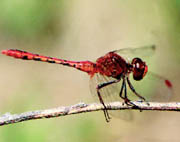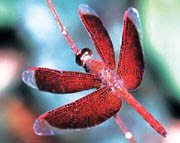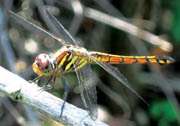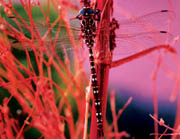
Earth's earliest flyers: Dragonflies
Dragonflies which belong to the insect order, Odonata are among the
most ancient of living creatures and are also one of the most beautiful
and spectation flying insects. The discovery of a fossilised dragonfly
with a wingspan of about 28 inches has proved that these insects were
around as far back as 300 million years, and the species we see today
which are of course much smaller, are their descendants.

Even though dragonflies may not capture your attention like
butterflies do, you will be surprised to learn that they have been the
subject of poetry and art, especially in China and Japan. If you check
out the national emblem of Japan, you will find that the dragonfly,
known as tonbo in Japanese, takes pride of place in it. In fact, Japan
itself is referred to as Akitsushima - the dragonfly island, by many.
The significance of this little creature is such in Japan that they
became the first country in the world to create a dragonfly nature
reserve. But, what's so special about these tiny flying insects to get
such attention, you may wonder? Let's find out...
General appearance
Dragonflies have long, narrow abdomens and their elongated bodies are
strikingly coloured in bright green, blue, red, yellow and violet.
The prominent eyes are multifaceted and may contain as many as 30,000
individual lenses or ommatidia and so, they have good eyesight. (Human
eyes have only one lens each.) They have a contracted thorax, three
pairs of legs, and two pairs of large delicate membraneous wings. Their
wings, which are richly veined, have a lace-like effect.
They breathe through spiracles (holes) in the abdomen as adults, but
as larva, they breathe through gills, as they live in water then. They
also have small, partially developed antennae.
Distribution
Dragonflies are an important part of wetland wildlife and play a
significant role in general ecology.

They are valued as a predator that helps control pests such as
harmful mosquitoes and other insects. Worldwide in distribution, with
more than 5,000 described species, they are found around lakes, ponds,
streams and wetlands. In North America alone, about 450 species have
been identified, while in Britain, about 38 different types have been
found. They are common in warmer parts of the world than in temperate
areas.
Perhaps influenced by the Greek word 'oden' which means 'tooth' and
refers to the toothed-jaws of these predatory ordonates, many believed
them to be strong stingers that were harmful to humans.
However, their formidable toothed-mandibles (lower jawbones), are
used on moths and other pest insects only, and not on humans. As people
believed they have a huge sting because of their long tails, they were
called 'Horse Stingers' and Devil's Darning Needles' in the U.K. But,
dragonflies do not sting. They may bite or nip, if they are caught by
the abdomen.
Differences in sub-orders
Odonata is an order of insects loosely known as dragonflies. There
are two main sub-orders: Anisoptera (dragonflies) and Zygoptera
(damselflies) which are very similar at a glance, but are different at
close examination. Anisoptera means 'unusual wings'.

Dragonflies are strong flyers while damselflies are not. They make
weak, fluttering flights. Majority of dragonflies have eyes that almost
touch each other at the top of the head, but the damselflies have eyes
which are well separated.
The fore and hind wings of dragonflies are larger and stronger and
are of different shapes. When at rest (perched on something), the wings
are held 180 degrees away from the body. Damselflies have fore and hind
wings which are similar and when perched, they are held close to the
body.
However, the damsel group known as spread wings hold them apart.
The larvae of dragonflies have gills which are projections within the
rectum, while damselflies have three, leaf-like appendages at the tip of
the abdomen.
Breeding methods and larva
Odonates breed and develop in clean water. The eggs are laid by the
females in two different methods and the shape of the eggs depend on the
method. Some insert eggs to plant matter above or below the surface of
the water. This is the primitive method.

The other method is to deposit the eggs direct into water or into mud
at the water's edge. The eggs are either long and cylindrical, or broad
and elliptical.
The larva go through a process of growing. In this immature period,
they are also called nymphs or naiads. They are entirely aquatic and
spend their time submerged in vegetation and in the bottom of pools.
Larva stage varies from 3-4 months or more.

The dragonfly larva have robust bodies that are somewhat
bullet-shaped, if they live among water plants. But if they live in the
bottom of deposits, they are flattened. Damselflies have slender or
cylindrical bodies and three conspicuous leaf-like gills, some of which
bear striking patterns.
Then, the skin cracks open on the thorax and the adult emerges. Some
limp at first, but after about an hour or more, are able to fly off. The
young adults instinctively fly away from water once they emerge. Then,
they go into a month's 'dispersal' period which is vital for their
survival.
The young adults emerge at night to avoid being eaten up by predators
such as water beetles, water bugs and ducks. However, in colder
environments, the adults emerge when it is warmer; at sunrise. Life
expectancy depends on which part they live in. Life cycle from egg to
death could be six months to even six years.
Food and behaviour
Dragonflies eat mosquitoes, midges and other insects. Fish spawn,
tadpoles and larva of other small insects are also eaten by dragonfly
larva. They are aggressive carnivores with a voracious appetite during
both larva and adult stage.

They are active during the day and spend a great deal of time in the
air hunting, defending territories and performing for a mate. It has
been found that males of some dragonfly species are very territorial and
defend their areas from other males.
As we said before, dragonflies are good flyers and can loop-the-loop,
hover and even fly backwards. The larger species are known to reach 30
kilometres per hour, even though they may flap wings in a relatively low
speed - less than 30 beats per second.

They can respond to stimuli from more than 40 feet away. They are
able to beat or flap their wings independently; the front wings going
down while the rear ones come up. They can manoeuvre quickly when
flying, making rapid zig-zag movements like hummingbirds.
Different types
The largest dragonfly in North America which is about six inches in
length is called the Giant Darner. The Citrine Forktail is less than an
inch, and is the smallest damselfly in North America.

Beautifully coloured dragonfly, species are found even in desert
habitats and their colours range from maroon, earth tones to metallic.
The Desert Forktail, Serpent Ringtail, Shadow Damsel, Painted Damsel,
and Rare-Desert Shadow Damsel are some of the desert species. Next time
you happen to see a dragonfly try to observe it and check out whether
it's a dragonfly or damselfly, going by the facts we've given in this
article. |


